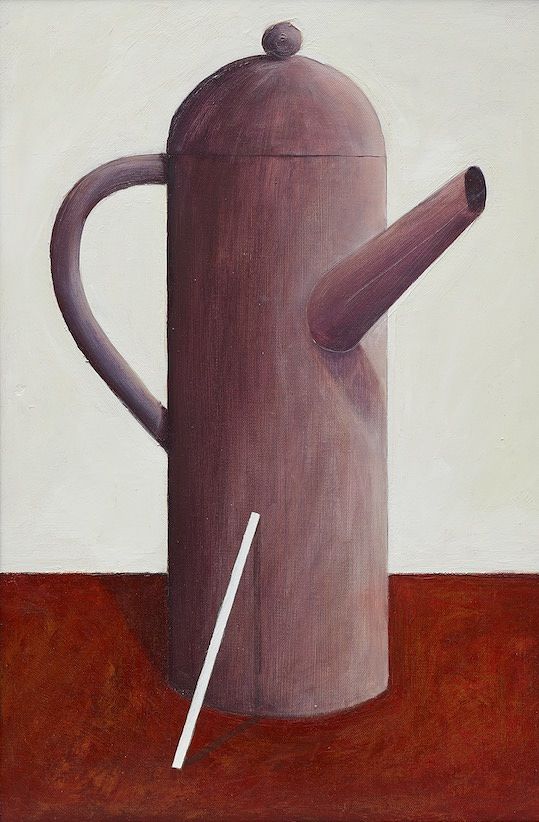Nicolas Party, Still Life, 2011. Estimate: £80,000 – 120,000. Wired: Online Auction.
First revealed during Nicolas Party’s MFA auction at the Glasgow School of Art, Still Life is an early example of the artist’s experimentation with the eponymous genre—and a wonderful example of his ability to infuse inanimate objects with life. Devised in warm, earthy tones, the painting combines clear figuration with passages of abstraction, a fusion exemplified by the thick diagonal white line resting against the prominent jug and the background revealing divided in off-white and carmine.
I think the element of timelessness is really fascinating with painting because there's so much tradition attached to it. –Nicolas Party
Rising higher than the central object’s typical size, Still Life demonstrates Party’s playfulness with scale, a theme he explores throughout his painterly and sculptural practice. Consistently employing a geometric formal language defined by cubes, cylinders, cones, spheres, and pyramids, Party creates a hierarchy of shapes that result in powerful paintings, at once both familiar and surreal.
The weight of Party’s visual lexicon is holistically incorporated in this early still life, as the pot at the center of the composition transcends both time and place; the recognizable and tangible shapes are rendered here in evocative hues. The timelessness of Party’s work also figures in its interdisciplinary nature, the influence of classical architecture (think: the Convent of San Marco by Fra Angelico in Florence) and Egyptian pottery. The geometric curvatures of religious arches are immediately recognizable in his sculptural and painterly renderings, where the curves of the teapot echo the masterfully crafted historic arches, giving the central object its volumetric appearance.

Paul Cézanne, Still Life with a Tin Kettle, 1869. Musée du Louvre, Paris. Image: Bridgeman Images.
In Still Life, Party draws on not only architecture but also the canon of still life and landscape compositions executed by masters from Jean-Baptiste-Siméon Chardin to Paul Cézanne, René Magritte, and Giorgio Morandi. Party explained, “If I paint an apple now, I know that the apple that Cézanne was painting was not the same one, but it didn't change. It's maybe a little bit more red now, but is more or less the same…But if you paint an iPhone and you're the only one to do it, in 50 years, nobody will know what it is.”
If you paint an iPhone and you're the only one to do it, in 50 years, nobody will know what it is. –Nicolas Party
Beyond the emphasis of subject and timelessness, Party applies lessons of focus and contemplation. Speaking of Giorgio Morandi, Party has said, “His paintings are telling us: there are no bottles outside of the frame, so concentrate on looking at the ones in the picture. It’s a very difficult exercise to look at an object with a great deal of attention—to look only with your eyes and try to forget what you are looking at.” Imbued with expertly-honed techniques passed down throughout the painterly tradition, the present work showcases Party’s mastery of oil painting in his own unique style.
Discover More from Wired: Online Auction >

Recommended Reading
Taking a Moment with Brian Calvin >
In Lynette Yiadom-Boakye's Work, Narrative Unfurls on the Canvas >
